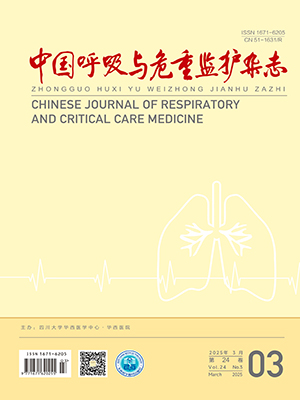Objective To evaluate the clinical value and safety of adenosine monophosphate( AMP)bronchoprovocation test in patients with asthma. Methods Sixty asthmatics, including 19 cases with uncontrolled asthma, 22 with partially controlled asthma, and 19 with controlled asthma were enrolled. Twenty-four healthy volunteers were enrolled as control and 20 patients with upper respiratory tract infection ( URI) were also included. AMP bronchoprovocation test ( AMP-BPT) was performed. PD20 FEV1-AMP lt;40 mg was set as a cut-off value of positive response to AMP. Positive rate, sensitivity, specificity, accuracy and adverse reactions of AMP-BPT were evaluated. Eleven cases with uncontrolled asthma and 12 cases with partially controlled asthma were followed up with AMP-BPT three months and six months after inhaled
corticosteroids treatment. Asthma symptom scores were recorded a week early before each challenge. The correlation between PD20FEV1 -AMP and asthma symptom score was analyzed. Values of PD20 FEV1 -AMP were represented as median and quartile range [ M( QR) ] . Results No positive responses to AMP were found in both healthy and URI subjects. On the other hand, positive responses to AMP were found in all the uncontrolled asthmatics ( 100% ) with PD20FEV1 -AMP as 0. 6 mg ( 0. 4 mg) , in 19 partially controlled asthmatics ( 86. 4% ) with PD20 FEV1 -AMP as 5. 38 mg ( 32. 67 mg ) , and in 5 controlled asthmatics( 26. 3% ) with PD20FEV1 -AMP as 40 mg ( 29. 3 mg) . There were negative correlations between the logarithms of PD20 FEV1 -AMP and logarithms of asthma symptom scores ( r = - 0. 598, P lt; 0. 01) . The sensitivity, specificity and accuracy was 72% , 100%, and 84% , respectively. Percentage of subjects who experienced wheezing, cough, dyspnea, swallows stimulation, chest tightness, expectoration and cyanosis during AMP-BPT were 37. 5%, 21. 2%, 15. 4%,7. 7%, 7. 7%, 4. 8%, and 1. 0%, respectively. No severe adverse reaction was found. Conclusions AMP-BPT is helpful to the diagnosis and differential diagnosis of bronchial asthma. It also can be used to evaluate the severity and control level, and to monitor the therapeutic efficacy in clinical practice. Moreover, AMP-BPT is well tolerated with little adverse reaction.
Citation: WU Fan,ZHENG Jinping,GAO Yi,ANJiaying,XIE Yanqing,LIU Wenting,YU Xinxin. Evaluation of Adenosine Monophosphate Bronchoprovocation Test in Asthmatics. Chinese Journal of Respiratory and Critical Care Medicine, 2009, 09(6): 558-564. doi: Copy
Copyright © the editorial department of Chinese Journal of Respiratory and Critical Care Medicine of West China Medical Publisher. All rights reserved




